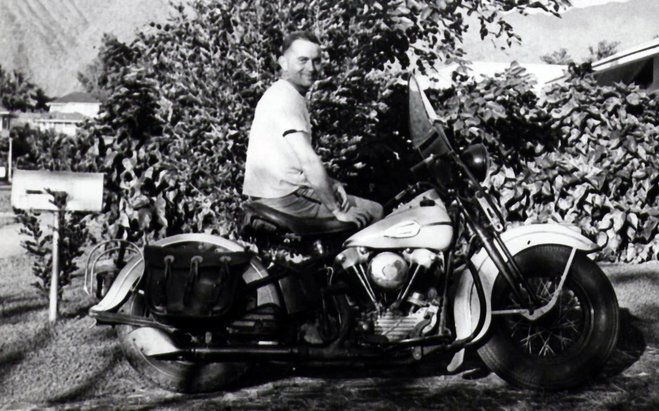Lots of people love their Harleys. Frank Latta loved his motorcycle so much that he took it with him to war aboard the American submarine Lagarto during the Second World War. Writer Meg Jones tells us the story of the Harley that may still be at the bottom of the ocean.
Submarines are cramped. Especially World War II subs. Not a lot of space for anything not absolutely necessary to operate the ship and keep the men inside alive. They were basically torpedoes where sailors skipped showers, grew beards and shared bunks with whoever worked the opposite watch. But what if I told you that at least one American submarine carried a Harley Davidson motorcycle on board during the war?
The submarine was the USS Lagarto and it was built in Manitowoc, Wisconsin where the shipworks in that city on Lake Michigan built 28 subs during World War II. They motored their way down to Chicago and over to the Mississippi River where they sailed through the Panama Canal to tangle with the Japanese navy in the Pacific Ocean.
Of the millions of Americans who enlisted in the military after Pearl Harbor, I’d like to think quite a few were gearheads who reluctantly left their motorcycles at home as they shipped out to boot camp. Not Frank Latta. He actually figured out a way to bring his wheels with him.
Latta was the captain of the USS Lagarto. He moved his wife and two young sons to Manitowoc in 1944 as shipyard workers finished building the submarine. At the ship’s launching ceremony, the submarine slid sideways into the water, throwing up a huge wave that drenched many of the onlookers.
No one living today knows exactly when or where Latta bought his Harley but the only photo of the submarine captain astride his beloved HOG shows what is believed to be a 1942 EL or FL model. The picture was likely taken in Hawaii. By the time Latta was assigned to the Lagarto he was a veteran of nine war patrols and had earned a Navy Cross, the second highest medal for valor.
Before shipping out on the Lagarto, Latta and his machinist’s mate disassembled the Harley, lowered the pieces into the narrow opening and stashed them wherever they could find room inside the submarine. When the Lagarto reached port and Latta had some free time, he assembled the pieces and roared off to see the sights.
The Lagarto sunk a Japanese submarine and a cargo vessel on its first war patrol in February 1945. The last anyone heard of the Lagarto was in early May off the coast of Thailand. It didn’t make radio contact, it didn’t return to port. Within a few weeks telegrams began to arrive at the homes of the 86 men on board, including Latta. The men were listed as missing in action. A year later they were officially declared dead. Their families could bury no bodies and they wouldn’t know what happened until six decades later when scuba divers found the shipwreck in 150 feet of water.
The Lagarto was upright and one of its outer torpedo doors was open. The rudder was turned hard to port and its dive planes set for a fast dive. That probably meant Latta had fired torpedoes at an enemy ship and then tried to flee a depth charge attack. But the Lagarto didn’t survive. In 2005 scuba divers reported seeing what looked like a huge hole punched in the side of the submarine. No hatches were open.
That means the 86 men are most likely entombed in the USS Lagarto. Frank Latta’s Harley is probably inside as well.








